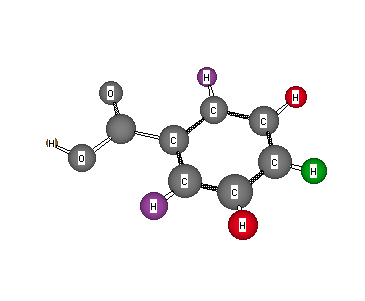Formula: C7H6O2
Answer: Benzoic Acid
Chemical Shift Assignments: 1H NMR: δ 7.50 (s, 2H), 7.64 (s, 1H), 8.14 (d, 2H), and 13.05 (s, 1H)
The degree of unsaturation is 5. Five of the hydrogen atoms are in the aromatic region. They comprise three different chemical shifts in a ratio of 2:2:1. This information accounts for C6H5-, a phenyl group. The remainder is -CO2H, which can be only a carboxyl (δ 13.05 ) with such a low field absorption. A formate ester, HCO2- is excluded based upon the chemical shift. The electron-withdrawing effect of the carbonyl group causes the hydrogens of the aromatic ring to have different chemical shifts [ortho (2), meta (2), and para (1)]. Clearly, the para hydrogen is at δ 7.64 because there is only one of them. The signal at δ 8.14 is deshielded by the CO2H group leaving the triplet at δ 7.50 as the meta hydrogens. The triplets for each aromatic signal is due to coupling (8.0 Hz) to its neighboring hydrogens.
The 13C spectrum displays singlets at: 172.90, 134.18, 130.54, 129.60, and 128.81. The weakest signal is at 129.60 ppm (ipso). The single para carbon is at 134.18 ppm, which is of lower intensity than the two ortho carbons at 130.54 ppm and the two meta carbons at 128.81 ppm. The ortho carbons are slightly deshielded by the electron-withdrawing CO2H group. The carbon of the carboxyl group is at 172.90 ppm. Return to Menu.
 |
oxygen-yellow
|
|---|